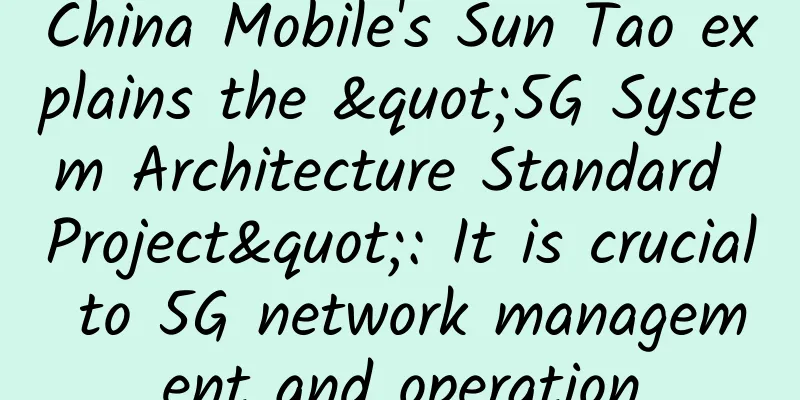China Mobile's Sun Tao explains the "5G System Architecture Standard Project": It is crucial to 5G network management and operation

|
At the 3GPP SA2#118 meeting held in Reno, the United States recently, the international mobile communication standards organization 3GPP officially launched the 5G system design. After heated discussions, China Mobile took the lead in the 5G system architecture standard project, and Dr. Sun Tao from the China Mobile Research Institute served as the first speaker of the project. 3GPP is the global mobile communication system industry technology standard setting organization, from 2G to 4G standards are set by it. Global mainstream communication operators and key manufacturers have been investing heavily in the hope of grasping the pinnacle of communication technology development. The project launched this time is the "5G System Architecture" of R15, referred to as 5GS, which is one of the basic standards related to the design of the entire 5G system, and also marks that the 5G standard has entered the substantive stage. What does it mean that China Mobile is leading the project? So, what does it mean for China Mobile to lead the 5G system architecture standard project, and how to become the rapporteur of the project? In this regard, Dr. Sun Tao said that the rapporteur is a specific term in standardization, which means the person in charge of the project, and is often the initiator, executor and final reporter of the project. The rapporteur is responsible for the overall advancement of the project and plays a vital role in the quality of the project completion. China Mobile's ability to lead the project among many competitions is not only a recognition of the technical strength of the rapporteur and his company, but also a recognition of the 5G system design ideas proposed by the rapporteur and his company, and even more so a recognition of their overall coordination and organizational capabilities, standardized image and reputation. Sun Tao introduced that China Mobile will take on many tasks in leading the project. For the project itself, on the one hand, it is necessary to formulate a work plan, output results, and coordinate meeting schedules; on the other hand, it is necessary to discuss and determine the 5G system architecture, functions, interfaces, processes, etc., coordinate the views of all parties on controversial issues, and organize intensive technical discussion telephone conferences. In short, it is necessary to be responsible for the overall advancement of the project and the quality of the two major technical standards output. In addition, as a reporter, it is also necessary to submit a standard progress report to the 3GPP plenary meeting, handle external coordination and liaison, and communicate with other international standardization organizations (such as ESTI NFV, BBF, ITU-T, etc.) on 5G-related work related to the project. What is the specific content and significance of the project? No one knows the 5G system architecture standard project better than Dr. Sun Tao. Dr. Sun Tao introduced the specific connotation and significance of this project. He said that in general, the design of the 5G overall system includes top-level design, wireless network design, core network design and other aspects. This project mainly carries out top-level design and core network design, and the design of architecture and core network is crucial to the management and operation of 5G networks, and is also of great significance to operators and the entire industry chain. Specifically, the official name of the 5G system architecture standard project is: 5G System Architecture (5G system architecture), referred to as 5GS. The project will standardize the 5G system architecture, functions, interface relationships, processes, roaming, and coexistence with existing networks. It also defines and standardizes 5G from the perspective of system design and end-to-end, and basically determines the appearance and networking form of the 5G network. Sun Tao introduced that the formulation of important standards by 3GPP is often divided into two stages: the first is the standard research stage, in which feasible technical solutions are studied and selected; the second is the formal formulation stage of the standard. The Next Generation System Architecture (NextGen) is a research project of 5GS. NextGen was established in October 2015, also led by China Mobile, and has received great attention from the entire industry chain. More than 55 industry parties from around the world support and work together. After a year of intensive research, a technical report TR 23.799 of more than 500 pages was formed. After intense discussions, a consensus was reached on the most basic issues about the 5G system, laying a good foundation for promoting the development of 5G networks towards a "service-based system architecture". What impact will the two basic standards formulated in December next year have on the final construction of 5G networks? It is reported that the project will formulate two basic standards, "Overall Architecture and Functions of 5G System" and "Basic Process of 5G System" in December next year. What far-reaching impact will these have on the final 5G network construction and actual scenario applications? In this regard, Sun Tao said that these two specifications are the formal standards to be output by the 5G System Architecture (5GS) project. They are the basic standards for defining and forming the 5G network system and determine the overall form of the 5G network architecture. These two standards also provide reference and basis for 5G-related technical standards, such as network management, protocol implementation, and security. Sun Tao believes that the "Overall Architecture and Functions of 5G Systems" mainly defines the overall architecture, main functions, logical relationships and interfaces, roaming architecture, and coexistence with existing systems. The "Basic Process of 5G Systems" will define end-to-end network processes, involving terminal and network intercommunication, and interaction between different network functions. These two specifications are the basic basis for 5G operators to build networks, manufacturers to develop equipment, and interconnection, and are the basis for further improvement and enhancement of subsequent 5G technologies. At present, the architecture of the 5G network is a new architecture with long-term influence and innovation. For example, "service-oriented", many control-plane-related business logics will be defined as "services", making the configuration of network functions more flexible and open; "network slicing-oriented", it can simultaneously form relatively independent network capabilities with different characteristics; "access independence", 5G considers a unified network architecture from the beginning of its design, while considering support for 5G access and non-cellular network access. |
<<: KT is forced to use "Korean speed" to make Gigabit "run" on copper cables
Recommend
From "eating meat" to "drinking soup": the difficult transformation of telecom operators
According to the established plan, the three majo...
Huawei and Yingke jointly launch the petrochemical smart factory 2.0 construction platform
Huawei (hereinafter referred to as Huawei), a lea...
Digital-vm 35% off all VPS starting from $2.6/month, 1-10Gbps bandwidth, KVM architecture, 8 data centers in the United States/Japan/Singapore
Digital-vm is a foreign VPS service provider esta...
Yecao Cloud year-end promotion: Hong Kong VPS annual payment starts from 138 yuan, Hong Kong dedicated server starts from 299 yuan/month
As 2022 is coming to an end, the Chinese business...
Why has 5G, which is on the cusp of the trend, not really exploded yet?
Recently, according to foreign media LADbible, th...
Stay at home and have fun during the Spring Festival without worrying about WiFi.
Many of my friends stayed at home during the Spri...
What issues should be paid attention to in the construction of office integrated network cabling?
The integrated wiring of the office will definite...
VirMach: $27.3/month-E3-1240v1/16GB/1TB/10TB/Los Angeles and other data centers
Last time, I shared the End of Life Plans series ...
LinkRunner G2 is a favorite of operators and maintenance personnel! See how NETSCOUT creates the "measurement" in the network testing industry
[51CTO.com original article] In recent years, I h...
Easy to understand: understanding the "weakness" and "slowness" of mobile networks
1. Introduction With the rapid development of mob...
Application and development of machine learning tools in data centers
At the beginning of the Internet, data centers we...
Thoroughly understand gateways, DNS, routing and related concepts: in-depth analysis of network communication basics
In the field of network technology, "gateway...
The new round of 5G construction blueprint is being drawn up, and the "multiplication effect" highlights the acceleration of industrial transformation
According to the "5G Industry Development Wh...
Follow WeChat! Weibo launches new emojis: they can also “split”
Weibo and WeChat are two well-known social platfo...
Unified Communications Market Trends Drive Spending Growth
Investment in on-premises unified communications ...









